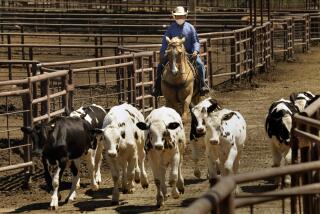By going vegan, America could feed an additional 390 million people, study suggests
More than 41 million Americans find themselves at risk of going hungry at some point during the year, the U.S. Department of Agriculture says.
But it doesn’t have to be this way. New research suggests the country could feed all 327 million Americans — plus roughly 390 million more — by focusing on plants.
If U.S. farmers took all the land currently devoted to raising cattle, pigs and chickens and used it to grow plants instead, they could sustain more than twice as many people as they do now, according to a report published Monday in the Proceedings of the National Academy of Sciences.
Set aside your cravings for cheeseburgers, bacon and chicken wings for a moment and consider the argument made by Ron Milo, a systems biology and sustainability researcher at the Weizmann Institute of Science in Israel, and his coauthors.
The researchers examined Americans’ eating habits and agricultural production in the years 2000 to 2010. For their calculations, they used a U.S. population of 300 million (in reality, it grew from 282 million to 309 million during that period, according to the Census Bureau).
With the help of computers, they figured out how to remove beef, pork, chicken, dairy and eggs from the American diet and replace them with plant-based foods that were “nutritionally comparable.” That means the replacement foods had to provide the same amount of calories, protein, fiber, vitamins and minerals without increasing fat or cholesterol — and they had to do it using the smallest amount of land possible.
Here’s what they found:
Imagine an area of land that can produce 100 grams of edible protein from plants. If you take that same amount of land and use it to produce eggs instead, you would end up with only 60 grams of edible protein — an “opportunity food loss” of 40%, the study authors found.
And that was the best-case scenario.
If that land were used to raise chickens, it would produce 50 grams of protein in the form of poultry. If it were devoted to dairy cows, it would provide 25 grams of protein in the form of milk products. If that land became a home for pigs, they would provide 10 grams of protein in the form of pork. And if you put cattle there, you’d get just 4 grams of protein in the form of beef.
Milo and his colleagues then scaled up their results to see how many more Americans could be fed by making each of those changes.
Eliminating eggs and replacing them with plants that offer the same nutrients would make it possible to feed 1 million additional people.
At the other end of the spectrum, swapping plants for beef would result in enough food to “meet the full dietary needs” of 163 million extra people.
In the middle were dairy (getting rid of it would result in food for 25 million more people), pigs (cutting them out would feed 19 million more people) and poultry chickens (without them, farmers could feed 12 million more people).
If beef, pork, chicken, dairy and eggs all were replaced by a nutritionally equivalent combination of potatoes, peanuts, soybeans and other plants, the total amount of food available to be eaten would increase by 120%, the researchers calculated.
To put that in perspective, the amount of food that’s currently wasted due to things such as spoilage and inefficient production methods is between 30% and 40% of what U.S. farmers produce.
“The effect of recovering the opportunity food loss,” the authors wrote, “is larger than completely eliminating all conventional food losses in the United States.”
That’s not to say there wouldn’t be a few downsides. Although a completely plant-based diet would provide more nutrients overall, consumption of vitamin B12 and a few other micronutrients would decline, the study authors noted.
The economic effects of eliminating all livestock-based agriculture are also unknown, they added. But two of the plusses include better health (which should reduce medical costs) and fewer greenhouse gas emissions, they wrote.
Even if you’re not ready to go vegan, Milo and his colleagues have certainly served up some food for thought.
Follow me on Twitter @LATkarenkaplan and “like” Los Angeles Times Science & Health on Facebook.
MORE IN SCIENCE:
Yes, a Chinese space station is about to plummet to Earth. Here’s why you don’t need to freak out
Alien mystery solved: Tiny skeleton belonged to a human girl with rare genetic defects
To avoid germs on an airplane, consider booking a window seat







